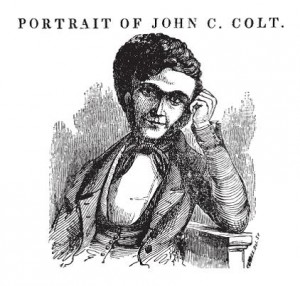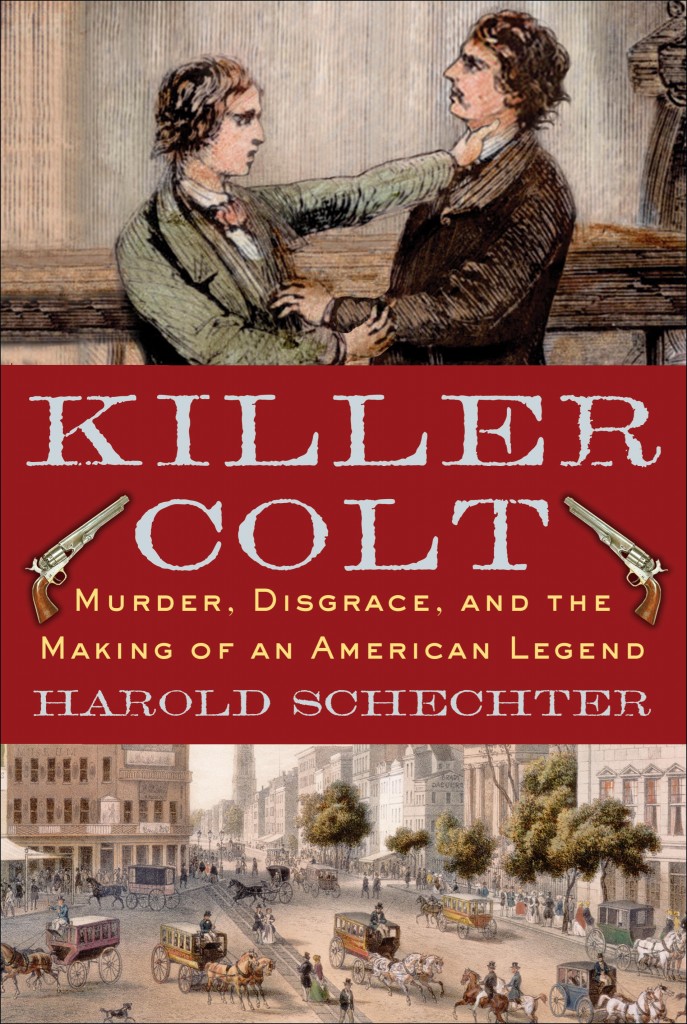By Harold Schechter
 In September 1841, a respected New York City printer named Samuel Adams showed up at the office of John Colt, a brilliant young accountant who had hired Adams to produce the latest edition of a popular textbook he had written. Adams had come to collect a debt. The two began arguing over the amount. The altercation ended when Colt killed Adams with a hatchet. He then stuffed the corpse into a crate and attempted to ship it off on a boat scheduled to depart the next morning. Unfortunately for him, a storm rolled in, preventing the ship from leaving port, and the murder came to light.
In September 1841, a respected New York City printer named Samuel Adams showed up at the office of John Colt, a brilliant young accountant who had hired Adams to produce the latest edition of a popular textbook he had written. Adams had come to collect a debt. The two began arguing over the amount. The altercation ended when Colt killed Adams with a hatchet. He then stuffed the corpse into a crate and attempted to ship it off on a boat scheduled to depart the next morning. Unfortunately for him, a storm rolled in, preventing the ship from leaving port, and the murder came to light.
Partly because of John’s prominence as the brother of Sam Colt, inventor of the six-shooter, his trial in January 1842 was a newspaper sensation. At one point – to counter charges that he had not only planned the murder but committed it with one of his brother’s newfangled weapons – Sam Colt himself was called on to demonstrate his six-shooter, putting on a marksmanship show in the courtroom. And then there was the much-anticipated appearance of Caroline Henshaw, John’s beautiful mistress who had just given birth to an illegitimate child.
Despite the best efforts of his lawyers, John was found guilty. While awaiting execution, he received permission to legitimize his relationship with Caroline. On the afternoon of November 18, 1842 – just before he was scheduled to go to the gallows – he and his mistress were wed in his cell. Afterwards the couple was permitted an hour’s conjugal visit alone. When the sheriff returned to fetch John and lead him to the scaffold, he found the condemned man lying dead, a knife protruding from his chest.
Shortly after these dramatic events, John’s widow Caroline and her newborn son departed for Europe. During the next several years, she was supported by regular payments from Sam Colt. In letters to acquaintances, Sam consistently put quotation marks around the word “nephew” when referring to Caroline’s son.
There was nothing accidental about the punctuation. It was Sam’s winking way of admitting a fact that would not become public for another twenty years. It appears that, during a business trip to Europe in 1835, Sam had met and impulsively married a poor but strikingly beautiful sixteen-year-old named Caroline. The startling truth – finally revealed after the death of the famed gun-maker – was that John’s mistress Caroline Henshaw and Sam’s first wife were the same person. Since bringing her back from Europe, Sam had managed to keep their marriage hidden from the world. In early 1841, eager to divest himself of a wife who could not advance his social ambitions, he had passed the docile Caroline on to his older brother, who took her as a lover, then wed her right before his own death.
About the author: Harold Schechter is Professor of American literature and culture at Queens College, CUNY. He has published more than thirty books and is the editor of the Library of America volume, True Crime: An American Anthology. www.haroldschechter.com

